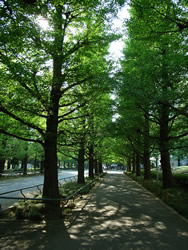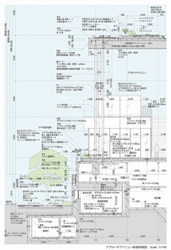Keio University Hiyoshi Campus Fourth Building, Independence Wing
Atrium skylight facilitates natural lighting / air flow / ventilation system
 |
|||
| Photograph of existing row of ginkgo trees | |||
 |
 |
 |
 |
 |
 |
 |
 |
The lower part of the atrium is continuously open, and the skylight uses a ventilation window type that is continuously open. For the atrium, a large-scale common area, this system of indoor-outdoor space was designed to maintain a comfortable environment while reducing the use of fossil fuels to an absolute minimum. The use of stack ventilation and wind-driven ventilation provide a continuous flow of wind through the atrium. (During winter, by closing the skylight ventilation window, the interior temperature is raised 5-10 degrees C above the outside temperature.) With a target of maintaining the temperature in populated areas at three degrees C lower than the outside temperature, we conducted a series of thermal environment simulations, which were used to determine the size of the ventilation window aperture. We also measured the brightness levels in a part of the campus where there is a pleasant row of ginkgo trees and utilized this data in simulations conducted to determine the size of the skylight and the method of lighting to be employed with the aim of attaining a similar level of brightness.
Intermediary spaces linking the campus with the the surroundings
 |
|||
| Cross-sectional plan of the approach avenue environs | |||
 |
 |
 |
 |
 |
 |
 |
|
Provision of a pedestrian space
Previously, along the western road frontage, Tsunashima Kaido, the campus was divided by a concrete retaining wall. A variety of innovations were incorporated into the building design with the aim of reducing exposure to noise and late-afternoon sun and enhancing the attractiveness of the sidewalk. The building has been set back from the road as far as possible to reduce pedestrians' feeling of enclosure. A five-meter-wide space bordering the road has been opened up to the local community as a walkway lined with zelkova trees. The design of the exterior wall face along that section of the building features the use of waste concrete from the previous building. In addition to giving the wall a less heavy appearance, this design utilizes recycled materials and the porous characteristics of the wall function as a means to prevent heat buildup from the late afternoon sun.
An approach avenue that regulates exposure to late-afternoon sun and road noise
At the same time as fulfilling the role of providing a pleasant approach to the building, the approach avenue was designed to act as a buffer. The large roof and vertical double louvers abate the late afternoon sun and road noise while providing privacy. Similar to the atrium, we conducted an array of simulations for such aspects as brightness level to determine the appropriate louver shape and pitch.
Previous Building |
 |
 |
 |
 |
 |
 Next Building Next Building |
CASBEE is a method for rating the environmental performance of buildings using Building Environmental Efficiency (BEE) as an indicator, which is based on the results of separate scores obtained for Q-1~Q-3 (Quality) and LR-1~LR-3 (Load Reduction).















 | Copyright © 2008 Institute for Building Environment and Energy Conservation, All Rights Reserved.
| Copyright © 2008 Institute for Building Environment and Energy Conservation, All Rights Reserved.